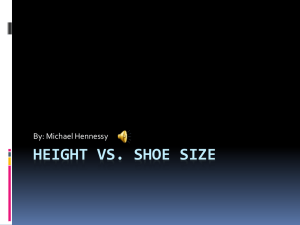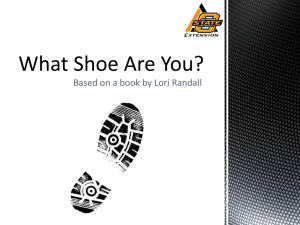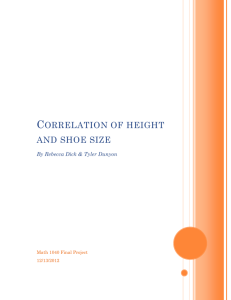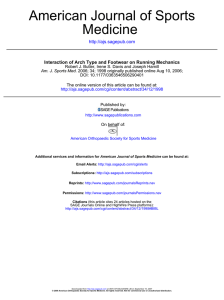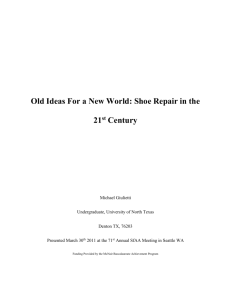Running Statistics
advertisement
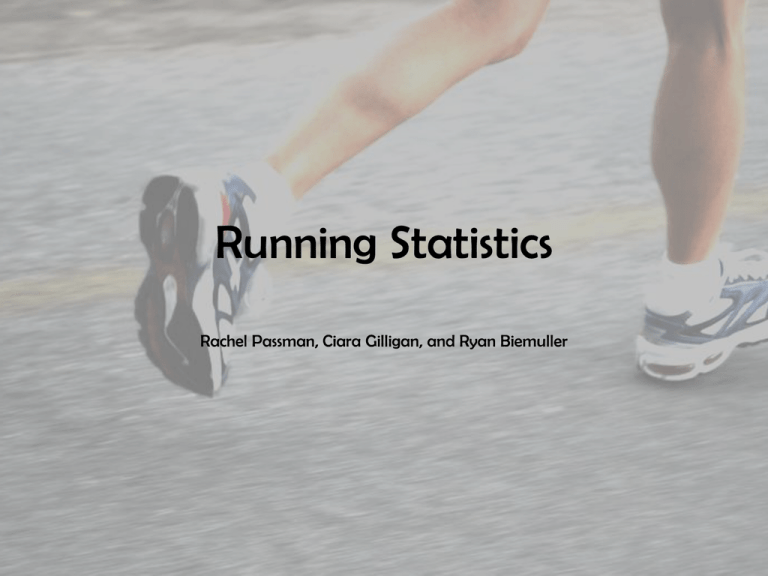
Running Statistics Rachel Passman, Ciara Gilligan, and Ryan Biemuller • Man started running out of necessity and was used for communication – Pheidippides was a messenger who brought news of battle • First sign of running as recreation – 3200m race at the Olympics in Egypt (3000 B.C) • 17th century, running was used for gambling purposes • Training for running began with Finn Paavo Nurmi and coach Pikala – Saw relationship between work and rest and understood importance of interval training – Training became known as the terrace training • 18th Century – Light weight leather shoe that can grip the ground • 19th Century – Croquet shoe with a rubber sole with a canvas upper with laces – Spiked leather shoes also invented • 20th Century – Created leather strip around shoe to reduce stretching (known today as Keds) – Converse sneakers • 21st Century – modern synthetic shoes are made of lightweight mesh fabric uppers and lightweight synthetic soles – chosen for maximum flexibility and comfort • The proportion of runners who wear legitimate running apparel • What running sneaker is most popular • What running sneaker is most popular within gender • We went to go certain locations and parks such as Meyer Way Park, Turk Park, IPW, and Kemper Park – Supposed to go to stores • Tried to go to parks at two different times – Early Saturday morning – After school Monday • We observed data of runners coming through the parks – Type of sneaker – Type of sneaker vs. gender – Running apparel Ho: The observed frequency distribution of type of running shoe fits the expected distribution. Ha: The observed frequency distribution of type of running shoe doesn’t fit the expected distribution. Assumptions: 1. SRS 2. All expected counts are greater than or equal to 5 x 2 =∑ 2 (obs-exp) / exp = 24.00 P(x^2>24I df=6)= 0.00052 1. assumed 2. check We reject Ho because our p-value is less than alpha which equals 0.05. We have sufficient evidence that the observed frequency distribution of the type of running shoe doesn’t fit the expected distribution. Ho: There is no association between the type of running shoe and gender variables. Ha: There is an association between the type of running shoe and gender variables. Assumptions: 1. 2 independent SRS 2. All expected counts are greater than or equal to 5 x 2 2 =∑ (obs-exp) / exp = 3. 741 P(x^2>3.741I df=6)= 0.71 1. assumed 2. no, but cont. We fail to reject Ho because our p-value is greater than alpha which equals 0.05. We have sufficient evidence that there is no association between the type of running shoe and gender variables Legit, 18 Not, 35 Ho: p=0.50 Ha: p<0.50 Assumptions: 1. 2. 3. SRS Np n(1-p) >10 Pop > 10n ^ Z= p-p/ 1. assumed 2. (53x 0.50) (53x0.50) 3. pop> 10x53 =-2.335 P(z<-2.335)= 0.02 > 10 (no, but cont.) We reject Ho because our p-value is less than alpha which equals 0.05. We have sufficient evidence that the proportion of people who wear legitimate apparel while running is < 0.50. • The most popular brand of shoe is not affected by gender • Most popular and least popular stay constant within both genders • More than 50% of runners do not wear legitimate apparel (wear shorts and tees) • Only analyzed runners in immediate area – Only observed runners in Bucks County • Only went to parks – Runners might not have been as legitimate as runners shopping in the stores • Didn’t include people running at home or at gym – Didn’t ask questions • If we were allowed to be in stores, we believed our legitimate apparel would have changed. – The shoe brands, such as Soucony and Brooks would be more popular • We believed prior to the test that Nike would be most popular and gender would have no affect on type of shoe.
